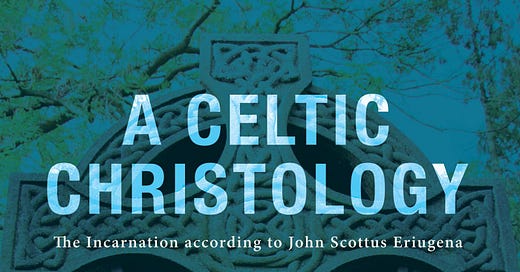Within the history of Ireland, there are few theological names celebrated to the extent of John Scotus Eriugena. Born in 9th century Ireland, Eriugena has almost become the face of Irish Christianity – he was even briefly depicted on the five-pound note. He had written several works, including some commentaries and a collection of poems, but his most notable work is the Periphyseon. Consisting of five separate books compiled into one text, the Periphyseon stands as a novel approach to Christian theology that influenced later Western theologians including the School of St. Victor and Nicholas of Cusa.
In his book A Celtic Christology: The Incarnation according to John Scottus Eriugena, John F. Gavin, S.J. sets out to explore Eriugena’s theology by explicitly focusing on his Christological views. In less than 200 pages, Gavin provides a detailed look into how Eriugena articulates a vision for Christ’s role in the redemption of humanity but also on how we participate in this plan. Gavin’s approach to writing balances scholarly rigor with readability, allowing his book to be read within and beyond academia, so that anyone can read it. This is certainly helpful, especially for those looking for a place to begin studying Eriugena’s other works. Outside of Dermot Moran’s The Philosophy of John Scottus Eriugena, there aren’t that many places to begin.
When discussing the Eriugenian corpus, it is important to note that the Periphyseon is a massive and complex tome. It is arguably one of the largest Christian philosophical texts outside of Scholastic thinkers such as Duns Scotus and Thomas Aquinas. It is a daunting text to study, let alone read, which is why Gavin’s approach to Eriugena’s Christology is so valuable. He provides a straightforward and engaging look into the Periphyseon that serves as a point of introduction for those looking to study the Irish monk’s theology. A Celtic Christology is by no means a primer on this text, and it doesn’t intend to claim this title, but serves as a comprehensive guide into one of many topics that Eriugena aims to teach.
As for the “Celticity” of A Celtic Christology, this is largely contingent on the extent of Eriugena’s Irish background within his works. The appellation of this term will be debatable among Celtic scholars and theologians who are uncertain about the Celtic or Gaelic nature of Eriugena’s theology. Aptly titled “Proclus of the West,” Eriugena was more distinctly an Irish-born Christian Platonist that certainly provided an original synthesis of Eastern and Western patristics. It is difficult to ascertain if his works had any indigenous Gaelic influence beyond any possible influence from the Irish exegetical tradition, which has been proposed by some scholars. This is all within the realm of academic debate, and beyond the interests of clergy and laity interested in connecting with their Gaelic roots.
Overall, Gavin’s A Celtic Christology offers a beneficial lens into the Christological foundations of Eriugena’s work. His analysis of Eriugena’s teachings is comprehensive and easily digestible, allowing anyone to gain a useful introduction into the Periphyseon. While the Irish nature Eriugena’s work is debatable, it is still a valuable resource for those interested in the development of Irish Christianity. I advise anyone interested in Eriugena’s work to buy A Celtic Christology, read it multiple times, and take plenty of notes.




Another very good book on Eriugena: The Voice of the Eagle - The Heart of Celtic Christianity (The Homily on the Prologue to the Gospel of St. John). Translated with an introduction and reflections by Christopher Bamford. Published by Lindesfarne Press 1980. Another book published by Lindisfarne in 1982 was the anthology by Christopher Bamford & William Parker Marsh: Celtic Christianity - Ecology and Holiness.